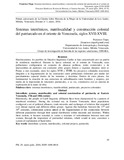| dc.rights.license | http://creativecommons.org/licenses/by-nc-sa/3.0/ve/ | |
| dc.contributor.author | Tiapa, Francisco | |
| dc.date.accessioned | 2016-02-25T20:26:59Z | |
| dc.date.available | 2016-02-25T20:26:59Z | |
| dc.date.issued | 2016-06 | |
| dc.identifier.issn | 1690-4818 | |
| dc.identifier.uri | http://www.saber.ula.ve/handle/123456789/41588 | |
| dc.description.abstract | Históricamente, los pueblos de filiación lingüística Caribe se han caracterizado por un patrón
de residencia matrilocal. Durante la época colonial, en el oriente de Venezuela, estas
poblaciones configuraron un conjunto de alianzas políticas, redes comerciales y de intercambios
de parientes con extensión sobre grupos étnicos y regiones distantes entre sí. Frente a este
escenario, entre los siglos XVII y XVIII, los proyectos coloniales estuvieron dirigidos a la
fragmentación de las conexiones entre poblaciones diferentes por medio del parcelamiento
espacial dentro de las misiones y doctrinas. Dentro de estos planes, fue fundamental la creación
de una estructura de subordinación entre hombres y mujeres, por medio de la imposición de
relaciones patriarcales, a su vez, constitutiva con un sistema de explotación de la mano de
obra. | es_VE |
| dc.rights | info:eu-repo/semantics/openAccess | |
| dc.subject | Sistemas interétnicos | es_VE |
| dc.subject | Matrilocalidad | es_VE |
| dc.subject | Patriarcado | es_VE |
| dc.subject | Proyectos coloniales | es_VE |
| dc.title | Sistemas interétnicos, matrilocalidad y construcción colonial del patriarcado en el oriente de Venezuela, siglos XVII-XVIII. | es_VE |
| dc.title.alternative | Interethnic systems, matrilocality and colonial construction of patriarchy at Eastern Venezuela, 17th and 18th century. | es_VE |
| dc.type | info:eu-repo/semantics/article | |
| dc.description.abstract1 | Historically, the people of Carib linguistic affiliation have
been characterized by a pattern of matrilocal residence. During the colonial era, in Eastern
Venezuela, these populations configured a set of political alliances, trade networks and
exchanges of relatives that extended over distant regions and different ethnic groups. Against
this backdrop, between the 17th and 18th centuries, colonization actions aimed at the
fragmentation of the connections between different populations through their spatial
distribution within missions and doctrines. Within these actions, it became essential to create
a structure of subordination between men and women, through the imposition of patriarchal
relations, which would in turn, constitute a system of exploitation of hand labor. | es_VE |
| dc.description.colacion | 45-76 | es_VE |
| dc.description.email | francisco.tiapa@gmail.com | es_VE |
| dc.description.frecuencia | Semestral | |
| dc.identifier.depositolegal | 200302ME1486 | |
| dc.publisher.pais | Venezuela | es_VE |
| dc.subject.facultad | Facultad de Humanidades y Educación | es_VE |
| dc.subject.institucion | Universidad de Los Andes (ULA) | es_VE |
| dc.subject.keywords | Interethnic systems | es_VE |
| dc.subject.keywords | Matrilocality | es_VE |
| dc.subject.keywords | Colonial projects | es_VE |
| dc.subject.keywords | Patriarchy | es_VE |
| dc.subject.publicacionelectronica | Procesos Históricos | |
| dc.subject.seccion | Procesos Históricos: Artículos | es_VE |
| dc.subject.thematiccategory | Artes y Humanidades | es_VE |
| dc.subject.tipo | Revistas | es_VE |
| dc.type.media | Texto | es_VE |


